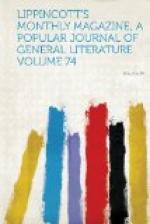[Illustration: New York building.]
The delicacy of the Asiatic touch is exemplified in the wood-carving upon the doorways and pediments of the Japanese dwelling. Arabesques and reproductions of subjects from Nature are executed with a clearness and precision such as we are accustomed to admire on the lacquered-ware cabinets and bronzes of Japan. With us, wood has almost completely disappeared as a glyptic material. The introduction of mindless automatic machinery has starved out the chisel. Mouldings are run out for us by the mile, like iron from the rolling-mill or tunes from a musical-box, as cheap and as soulless. Forms innately beautiful thus become almost hateful, because hackneyed. If all the women we see were at once faultlessly beautiful and absolute duplicates of each other in the minutest details of feature, complexion, dress and figure, we should be in danger of conceiving an aversion to the sex. So there is a certain pleasure in tracing in a carven object, even though it be hideous, the patient, faithful, watchful work of the human hand guided at every instant by the human eye. And this Japanese tracery is by no means hideous. The plants and animals are well studied from reality, and truer than the average of popular designs in Europe a century ago, if not now. It is simple justice to add that for workmanlike thoroughness this structure does not suffer in comparison with those around it.
Besides this dwelling for its employes, the Japanese government has in a more central situation, close to the Judges’ Pavilion, another building. The style of this is equally characteristic. Together, the two structures will do what houses may toward making us acquainted with the public and private menage of Japan.
[Illustration: Pennsylvania building.]
In the neat little Swedish School-house, of unpainted wood, that stands next to the main Japanese building, we have another meeting of antipodes. Northern Europe is proud to place close under the eye of Eastern Asia a specimen of what she is doing for education. Sweden has indeed distinguished herself by the interest she has shown in the exposition. At the head of her commission was placed Mr. Dannfeldt, who supervised her display at Vienna. His activity and judgment have obviously not suffered from the lapse of three years. This school-house is attractive for neatness and peculiarity of construction. It was erected by Swedish carpenters. The descendants of the hardy sea-rovers, convinced that their inherited vigor and thrift could not be adequately illustrated by an exclusively in-doors exhibition, sent their portable contributions in a fine steamer of Swedish build, the largest ever sent to sea from the Venice of the North, and not unworthy her namesake of the Adriatic. To compete in two of its specialties with the cradle of the common school and the steamship is a step that tells of the bold Scandinavian spirit.




